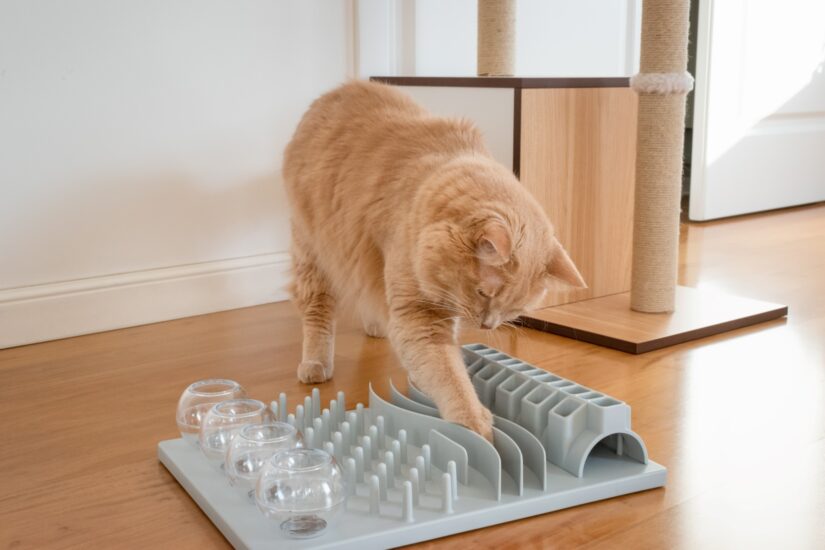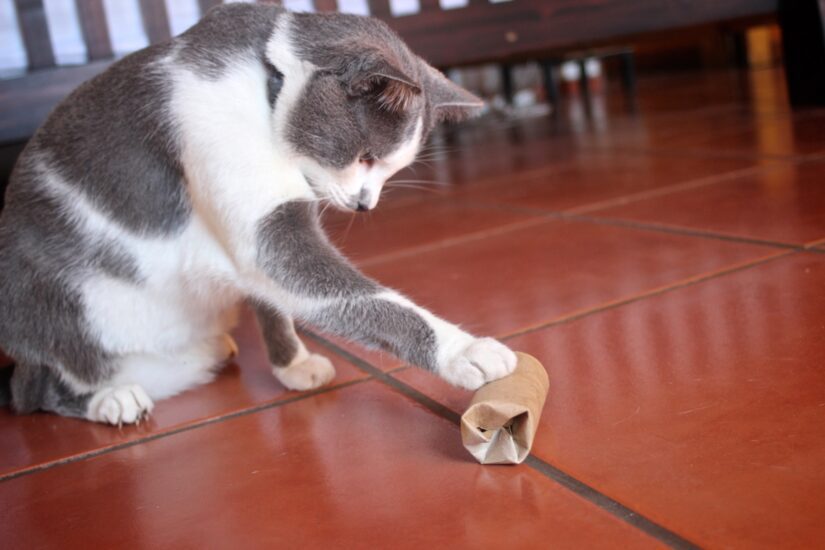Cats are commonly believed to be low maintenance, independent pets. Provide them with food, water, a litter box and perhaps a scratching post and some toys, and they’ll amuse themselves, right?
Not so fast! While they may not need long walks in the park, cats require interaction and stimulation — just like dogs do — to stay mentally and physically healthy. The indoor environment can be a monotonous one. Cats who are bored or frustrated may display stress-related behaviours such as re-directed aggression or over-grooming. The indoor lifestyle can also be sedentary. Inactive cats may be at risk of obesity, diabetes, arthritis and other associated medical problems. However, it is easy to combat all of this and provide added enrichment for your cat.
Born to hunt
As predators, cats have evolved to work for their food. Eating from a bowl, however, doesn’t provide them with much opportunity for problem-solving. This is where puzzle feeders come in. Puzzle feeders can be a great way to engage your cat’s mind and body, particularly if she happens to be highly food-motivated.

Despite their motivation to hunt, it can take time for cats to learn how to use a puzzle feeder. Just assuming they’ll get it right away could mean they’ll end up going hungry. The key is to go at your cat’s pace. This will help prevent her from becoming frustrated and giving up.
Set your cat up for puzzle-feeder success:
1. Avoid introducing the puzzle feeder on a full stomach
It may sound obvious but make sure that your cat is at least a bit hungry the first time you introduce the puzzle feeder to her! That way, she’ll be more motivated to investigate it.
2. Give your cat a choice
Continue to let your cat have the choice between the feeder and her food bowl. (Keep in mind that she’ll now be getting her meals from more than one source. Make sure she’s not eating more kibble in a day than she normally would to maintain a healthy weight!)
3. Start with a simple puzzle feeder design
Clear puzzle feeders with multiple openings will let your cat see, smell and hear the food inside more easily.

4. Make it easy for your cat
Adjust the settings to make it as easy as possible for your cat to get food from the feeder (for instance, widen the openings). That way, she’ll be rewarded more quickly, which should increase her motivation to continue trying it.
5. Get your cat’s attention
Sprinkle some kibble around the puzzle feeder. This will help your cat to make the connection between this strange new object in her environment and food. If she doesn’t seem to know what to do, try pointing to the feeder. When your cat approaches or gently sniffs it, move the feeder slightly and cause a kibble to fall out. Let your cat eat the kibble and repeat. Eventually, she should start manipulating the feeder on her own.

My cat’s caught on quickly — now what?
As your cat becomes more proficient at using the puzzle feeder, and doesn’t show signs of stress (such as increased yowling or restlessness), you can change the settings to make it more difficult. Over time, you can also put more kibble in the feeder and less in her bowl. Some cats are able to have their entire day’s worth of food provided in a puzzle feeder. For others, it’s best used with their favourite treats as occasional enrichment.
Should your cat prove herself to be especially adept, you can introduce new, more challenging puzzle feeders down the road. Just continue to monitor her use of them to ensure she finds the activity stimulating but not frustrating.
DIY puzzle feeders for cats
Interested in puzzle feeders but want to save some money? Try these two designs you can easily make from items around your home:
- Cat tube treat tower (PDF)
- Cat puzzle box (PDF)
More tips for keeping an indoor cat happy and healthy.

